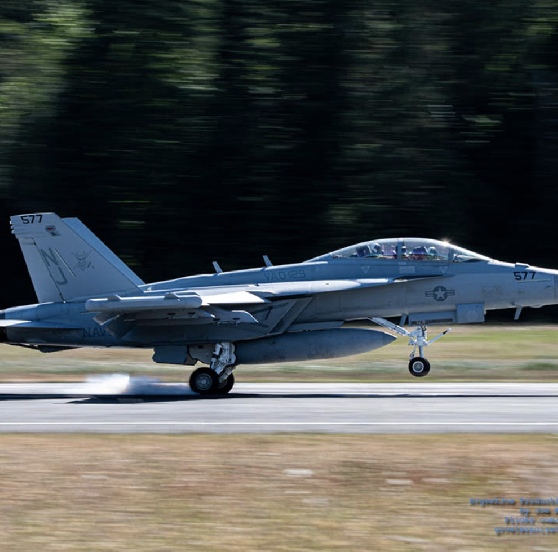How Growler jets are impacting our region
Oct 9, 2023
Have you heard the roar of the Growler jets overhead during the day and evening? I have. Have your conversations, your work or your sleep have been disrupted by thunderous jet noise? That’s true for me.
Based at Naval Air Station Whidbey Island, the EA-18G Growler emits a deep rumbling noise that gives it its name. While the jets are practicing takeoff and landing from Whidbey, their flight routes extend over the Salish Sea, over our homes.
The Navy’s own 2018 Environmental Impact Statement (EIS) and 2020 Supplemental EIS identify that jet noise levels heard on the ground can be as loud as 121 decibels (dBA). That’s what you experience in front of a rock band, or a chainsaw running next to your head. Imagine hearing that on a regular basis, for five long minutes, or spread over hours.
The obvious concern is hearing damage. Studies show there are other serious impacts such as increased blood pressure, sleep disturbance, stress and interference with childhood learning. Scientists also found that the noise impacts orcas, birds and others. It impacts our quality of life and realtors find that property values are impacted in some areas.
In preparing their EIS, the Navy uses noise averaging to represent typical noise over a day. This approach was developed by the Federal Aviation Agency (FAA) in its 1979 Airport Noise Policy for commercial airports. Think of hitting your finger with a hammer. It hurts tremendously, but averaged over the day it may not be too bad. But the damage was done.
In addition, the FAA policy only focuses on the frequencies that our ears respond to. The FAA ignores the low frequencies that the Growler engines produce, so they are under-measuring the impacts.
This year the FAA started a review of its 1979 Airport Noise Policy. We hope that they will change how they limit noise in their arena and then the Department of Defense follows for military aviation noise.
For decades residents in our Salish Sea communities have been impacted and concerned about the increased operations out of Naval Air Station Whidbey Island. Residents in Island and San Juan Counties began organizing in the early 1990s, when they gathered to stop the Prowler training flights over the islands. In 2005 the Navy completed an Environmental Impact Assessment to replace the Prowlers with the significantly louder EA-18G Growler.
It’s shocking that few studies on health impacts of jet noise near airports have been done in the United States. However, now the Growler Health Impact Project, funded by the University of Washington’s Population Health Initiative, is analyzing troves of raw Growler jet noise data collected over the past decade.
The study has three major objectives:
-Provide a robust assessment of Growler noise levels, length of exposure, and frequencies
-Estimate the health risks to the population
-Map estimated noise levels and related noise health risks to inform affected communities about how to protect and advocate for their health.
This project is ongoing.
When the Navy proposed to deploy the Growlers, concerned residents in San Juan County coalesced and created the informal group Quiet Skies Over San Juan County (QS). There are 350 people on our email list.
Given impacts around the Salish Sea, several local groups in the region impacted by the Growlers, including QS, formed the Sound Defense Alliance (SDA). Included are Skagit, Island, San Juan, Jefferson and Clallam Counties. SDA gives us a stronger voice in responding to the Navy and keeping our county, state and federal elected officials aware and to deliver the message to the Navy.
A website developed by San Juan County in 2014 enables individuals in all impacted areas to report Growler noise events. Volunteers in QS develop reports from the data including graphs, analysis and maps. This information is important to providing real data to challenge the Navy and to provide information for research. You can review these data reports here.
Surprised about Growler noise over Jefferson and Clallam Counties? While these counties are far away from Naval Air Station Whidbey Island, Growlers use the Olympic National Park as a warfare practice range. The quietest place on earth now regularly endures ear-splitting Growler flights.
Lawsuits have aimed at mitigating this region-wide situation. Most recently, a U.S. District Court judge ruled that the Navy could continue running the increased number of jet flights at its base on Whidbey Island but must redo its EIS due to deficiencies.
If you are concerned about Growler noise I recommend that you get informed, contact your elected officials and support the local organizations.
Further information can be found at these three websites:
Quiet Skies
Sound Defense Alliance
Citizens of Ebeys Reserve
�" Contributed by Christine Kerlin, for Quiet Skies over San Juan County
Based at Naval Air Station Whidbey Island, the EA-18G Growler emits a deep rumbling noise that gives it its name. While the jets are practicing takeoff and landing from Whidbey, their flight routes extend over the Salish Sea, over our homes.
The Navy’s own 2018 Environmental Impact Statement (EIS) and 2020 Supplemental EIS identify that jet noise levels heard on the ground can be as loud as 121 decibels (dBA). That’s what you experience in front of a rock band, or a chainsaw running next to your head. Imagine hearing that on a regular basis, for five long minutes, or spread over hours.
The obvious concern is hearing damage. Studies show there are other serious impacts such as increased blood pressure, sleep disturbance, stress and interference with childhood learning. Scientists also found that the noise impacts orcas, birds and others. It impacts our quality of life and realtors find that property values are impacted in some areas.
In preparing their EIS, the Navy uses noise averaging to represent typical noise over a day. This approach was developed by the Federal Aviation Agency (FAA) in its 1979 Airport Noise Policy for commercial airports. Think of hitting your finger with a hammer. It hurts tremendously, but averaged over the day it may not be too bad. But the damage was done.
In addition, the FAA policy only focuses on the frequencies that our ears respond to. The FAA ignores the low frequencies that the Growler engines produce, so they are under-measuring the impacts.
This year the FAA started a review of its 1979 Airport Noise Policy. We hope that they will change how they limit noise in their arena and then the Department of Defense follows for military aviation noise.
For decades residents in our Salish Sea communities have been impacted and concerned about the increased operations out of Naval Air Station Whidbey Island. Residents in Island and San Juan Counties began organizing in the early 1990s, when they gathered to stop the Prowler training flights over the islands. In 2005 the Navy completed an Environmental Impact Assessment to replace the Prowlers with the significantly louder EA-18G Growler.
It’s shocking that few studies on health impacts of jet noise near airports have been done in the United States. However, now the Growler Health Impact Project, funded by the University of Washington’s Population Health Initiative, is analyzing troves of raw Growler jet noise data collected over the past decade.
The study has three major objectives:
-Provide a robust assessment of Growler noise levels, length of exposure, and frequencies
-Estimate the health risks to the population
-Map estimated noise levels and related noise health risks to inform affected communities about how to protect and advocate for their health.
This project is ongoing.
When the Navy proposed to deploy the Growlers, concerned residents in San Juan County coalesced and created the informal group Quiet Skies Over San Juan County (QS). There are 350 people on our email list.
Given impacts around the Salish Sea, several local groups in the region impacted by the Growlers, including QS, formed the Sound Defense Alliance (SDA). Included are Skagit, Island, San Juan, Jefferson and Clallam Counties. SDA gives us a stronger voice in responding to the Navy and keeping our county, state and federal elected officials aware and to deliver the message to the Navy.
A website developed by San Juan County in 2014 enables individuals in all impacted areas to report Growler noise events. Volunteers in QS develop reports from the data including graphs, analysis and maps. This information is important to providing real data to challenge the Navy and to provide information for research. You can review these data reports here.
Surprised about Growler noise over Jefferson and Clallam Counties? While these counties are far away from Naval Air Station Whidbey Island, Growlers use the Olympic National Park as a warfare practice range. The quietest place on earth now regularly endures ear-splitting Growler flights.
Lawsuits have aimed at mitigating this region-wide situation. Most recently, a U.S. District Court judge ruled that the Navy could continue running the increased number of jet flights at its base on Whidbey Island but must redo its EIS due to deficiencies.
If you are concerned about Growler noise I recommend that you get informed, contact your elected officials and support the local organizations.
Further information can be found at these three websites:
Quiet Skies
Sound Defense Alliance
Citizens of Ebeys Reserve
�" Contributed by Christine Kerlin, for Quiet Skies over San Juan County

A Boeing EA-18G Growler makes a touch-and-go landing at Naval Outlying Field Coupeville on Whidbey Island. Flight routes â€" and their impacts â€" extend across the Salish Sea. (AvgeekJoe, CC BY 2.0 via Wikimedia Commons)

